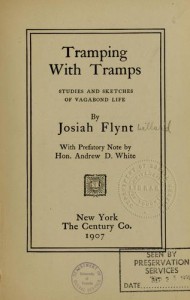The Setting
The hobo culture that prompted the creation of tramp language dictionaries can be traced to the United States of America. In 1893 hobos comprised 1 percent of America’s male population, and used extensive systems of communication to relay information between one another regarding their travel and work.1 This form of slang developed as a way in which tramps and hobos could talk to each other while keeping the nature of their conversations hidden from outsiders.2 In contrast to cant, the purpose of hobo-talk was not so much to trick victims of crime or evade the police, but more as a way of maintaining exclusivity and to ensure that only those intimately connected with the hobo’s way of life could be a part of conversations between hobos.3 Hobos often had spent time in prison, and thanks to prison libraries, hobos were often well read individuals, but there were times when their own vocabularies could not make certain thoughts and feelings clear, necessitating the creation of their own language.4
Popular Discourse
General consensus among the public was that homelessness threatened the American way of life. This stemmed largely from the competition for employment that hobos presented for settled citizens, and the possibility of sons and, less commonly, daughters leaving their families to become hobos.5 As a result of the perceived threat of homelessness on property, jobs, and family, the general public tended to view hobos as criminals. Helping to inform this viewpoint is the similarity between the language of criminals and hobos, owing to the fact that many tramps were either former or failed criminals.6 Consequentially, the language of hobos and tramps tended to be viewed as cant rather than slang due to the association between crime and homelessness.
Example Book
One notable example of a written work concerned with tramp language is Tramping With Tramps written by Josiah Flynt Willard (1869-1907). This book is autobiographical in nature, and includes a detailed discussion of tramp language courtesy of Willard.7 Willard comments that due to importance of language for tramps and hobos, being able to use tramp language is of utmost importance if one is to associate with them; at the same time, Willard stresses that the secrecy of tramp language makes it impossible to learn this language from a dictionary.8 Instead of learning this language from a book, Willard explains that the way in which one acquires knowledge of tramp-talk is by moving between the world of the civilized citizen and the hobo.9
1 Coleman Vol. III, 276
2 Coleman Vol. III, 277
3 Coleman Vol. III, 277
4 Coleman Vol. III, 278
5 Coleman Vol. III, 277
6 Coleman Vol. III, 278
7 Coleman Vol. III, 277
8 Coleman Vol. III, 277
9 Coleman Vol. III, 278
